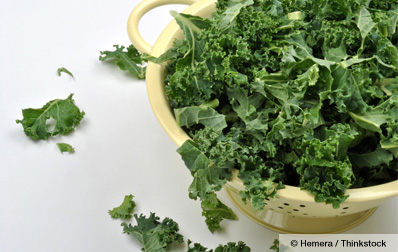Hail to Kale!

One variety is known as dinosaur kale in Tuscan regions for its glossy, crinkly, green-to-violet-colored leaves. Kale has a relatively short life in terms of crispness, so it’s best to use within a few days of harvesting.Botanical name: BorecoleThriving even in frost, kale is an easy-to-grow green that keeps on giving: cut the smaller, paler green leaves to anchor or mix into fresh garden salad; use the larger, dark greens for stir-fries, pizza topping, or soup, while the plant keeps right on growing.
Health Benefits of Kale
If vitamins could be packaged and labeled as such, they would look very much like kale. That’s because the vitamins offered by just one cup of this relatively little-known veggie can trump a whole week’s worth of other foods: 684% of the daily value of vitamin K, 206% of the suggested daily amount of vitamin A, and 134% of vitamin C (and even more vitamin C in the Scottish curly-leaf variety).
Kale can legitimately be called a superfood, if only after one particular study, which reported the high antioxidant activity in this vegetable. The phytonutrient indole-3-carbinol aids in DNA cell repair, while at the same time slowing the growth of cancer cells. With its sulforaphane content, kale protects against prostate and colon cancers. It also has properties that studies show ca ease lung congestion, and is beneficial to your stomach, liver, and immune system. It contains lutein and zeaxanthin, which help protect your eyes from macular degeneration.
Kale has been compared to beef, which is known as a “go-to” food for iron, protein, and calcium. Kale’s anti-inflammatory capabilities are unrivaled among leafy greens, especially relating to the prevention and even reversal of arthritis, heart disease, and several autoimmune diseases.
Omega-fatty acids are called essential because your body needs them to remain healthy, but they need to come from sources outside the body; kale is an excellent source of these healthy fats. Benefits of these often-talked about but little understood compounds include their ability to help regulate blood clotting, build cell membranes in your brain, and protect you against heart disease and stroke. They may also help combat autoimmune diseases, such as lupus and rheumatoid arthritis.
One serving of kale contains 121 milligrams of omega-3 fatty acids and 92.4 milligrams of omega-6 fatty acids.
Kale is one of the best vegetables for your health. See: The Best and Worst Vegetables to Eat
Kale Nutrition Facts
Serving Size: One cup (67 grams) of raw kale
Amt. Per Serving
Calories
33
Carbohydrates
7 g
Protein
2 g
Fiber
1 g
Potassium
299 mg
Studies Done on Kale
According to one study1, among all the foods involved in the research, kale was shown to have the highest protective effect against bladder cancer, the sixth most commonly diagnosed cancer in the U.S.
Kale has a very impressive number of flavonoids, each with its own healthy job to do in your body, including 32 phenolic compounds and three hydroxycinnamic acids, which can help keep cholesterol levels within the normal range and scavenge harmful free radicals in your body2. Two of the most important flavonoids kale has in abundance are kaempferol and quercetin.
It should be noted that the effectiveness of several antioxidants and vitamins in kale are diminished when cooked3.
Kale Healthy Recipes: Tuscan Bean and Kale Soup
Kale Healthy Recipes
Ingredients:
1 pound dried cannellini beans
2 Tbsp. coconut oil
1 large onion, minced
2 large garlic cloves, minced
1 Tbsp. minced fresh sage
2 tsp. minced, fresh rosemary
7 cups chicken or vegetable stock
1/3 pound of kale, ribs removed, coarsely chopped
Salt and freshly ground black pepper
Procedure:
In a large saucepan, cover the dried beans with water (completely) and soak overnight. Drain and rinse.
Heat 2 tablespoons of oil in a large pot over moderate heat. Add onion and sauté until soft, about 5 minutes. Add garlic, sage and rosemary and sauté for 1 minute.
Add beans and stock. Cover and adjust heat to maintain a gentle simmer, cooking until the beans are almost tender – about 1 hour, then add the kale.
Cover and continue simmering until the beans and vegetables are tender.
Remove pot from heat and mash some of the beans against the side of the pot until soup is a nice, hearty consistency, adding water if necessary. Season to taste with salt and pepper.
This recipe makes six servings.
(From Healthy Foods for Your Nutritional Type by Dr. Joseph Mercola)
Kale Fun Facts
Kale was first cultivated from wild varieties by the Greeks and Romans and later spread throughout Europe, where the leaves were called “coles,” and then to the British Isles. From there it was transported to the Americas. The first time it was recorded in the U.S. was in 1669, referred to as “colewarts.”
Summary
A Brassica that’s made a name for itself as one of the healthiest foods grown in the garden – or found in local farmer’s market or supermarket produce section, for that matter – kale is becoming better known in the U.S., not just for the distinctive flavor it brings to soups and salads, but because of the many health benefits it provides. Loaded with vitamins, eating this green vegetable helps you fight cancer, heart disease, autoimmune diseases, and even macular degeneration. With all these good things, it could be what’s for dinner.
Learn more about foods that not only offer a sensational taste, but can also help you get on the road to optimal health today.

No comments:
Post a Comment